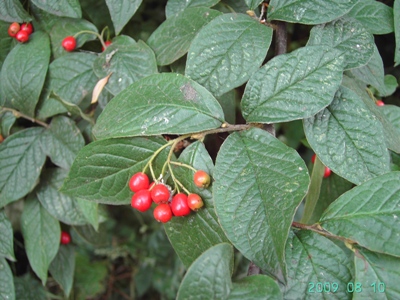Cotoneaster rehderi Pojarkova, Not. Syst. Inst. Bot. Acad. Sci. USSR 17: 184, 1955.
Synonym: C. bullatus Bois var. macrophyllus Rehder & E.H. Wilson
Section Acutifolii, series Bullati
Origin: China (Sichuan, Yunnan).
Presence in western Europe: Naturalized in Germany (John & Frank 2008; Dickoré & Kasperek 2010; as C. bullatus s.l.) and Great Britain (Stace 2010). Furthermore known from France (Farille & al. 2010). Doubtlessly present in many other parts of Europe.
Cultivation in Belgium and the Netherlands: “common” (De Koning & van den Broek 2009; as C. bullatus s.l.).
Comparative taxonomy: Cotoneaster rehderi is here accepted as a segregate of C. bullatus, following Fryer & Hylmö (2009). Dickoré & Kasperek (2010) and Flora of China (Lingdi & Brach 2003) accept the latter in a wide sense as to include Cotoneaster rehderi. Dickoré & Kasperek l.c. simply reduce it to synonymy (along with Cotoneaster boisianus Klotz and C. reticulatus Rehder & E.H. Wilson). Lingdi & Brach l.c. adopt a deviating taxonomy and accept four varieties under Cotoneaster bullatus, mainly based on the number of flowers per inflorescence and leaf dimensions. Var. macrophyllus corresponds with Cotoneaster rehderi and var. bullatus represents the typical variety. Var. floribundus (Stapf) L.T. Lu & A.R. Brach is a synonym of Cotoneaster ignescens J. Fryer & B. Hylmö (and identical with C. bullatus cv Firebird) while var. camilli-schneideri (Pojarkova) L.T. Lu is in fact a rather different species (C. camilli-schneideri Pojarkova) from another series (series Glomerulati).
Illustrations: Grevtsova (1999; erroneously as “C. rechderi”), Henker & Kiesewetter (2006), Fryer & Hylmö (2009), Stace (2010). See also: http://www.british-wild-flowers.co.uk/C-Flowers/Cotoneaster,%20Bullate.htm.
Cotoneaster rehderi was apparently first collected by a railway track in the port of Antwerpen in 1983 (D’hose & De Langhe 1984; erroneously as “C. bullata”). Since the 1990’s it has been increasingly recorded in numerous localities in large parts of Belgium and now probably is one of the most frequently encountered species of the genus.
Cotoneaster rehderi has been observed in a wide range of habitats in Belgium, artificial as well as natural ones: by railway tracks, urban wasteland, (on the verge of) deciduous and coniferous woodland, coal mining heaps, old walls (including quays), coastal dunes, abandoned railway yards and industrial areas, gravel pits, foot of hedges, chalk and ash deposits, etc. It was also recorded as an epiphyte in pollard willows. Cotoneaster rehderi mostly occurs in half-shade (more rarely and much less vigorous in sun-exposed sites), most often on dry, calcareous soils. It seems to be rare or absent in regions with a more acidic substrate. Despite being one of the most frequent species of the genus, Cotoneaster rehderi rarely occurs in large populations in Belgium. Obviously naturalized, dense stands are present for instance in the Groene Vallei in Gent (a former demolition site, now completely turned into an exotic urban woodland).
In the absence of fruits Cotoneaster rehderi may be confused with several other species (although there are rather few species with large, strongly bullate leaves in the wild in Belgium). Series Bullati encloses 19 species (Fryer & Hylmö 2009), some of which are rather poorly distinguished. Cotoneaster rehderi is readily distinguished from C. moupinensis by its berries that remain red at maturity (not turning purplish-black) and its leaves that are much more bullate (veins very deeply impressed). It is obviously closer to Cotoneaster bullatus and mostly distinguished on quantitative features: larger leaves with veins more deeply impressed, inflorescences often with more flowers, larger fruits, etc. The main differences between both species are summarized in the table beneath.
|
C. rehderi |
C. bullatus |
|
Leaves 70-210 x 45-90 mm, with veins very deeply impressed (strongly bullate) |
Leaves 55-90 x 26-46 mm, with veins moderately impressed (slightly bullate) |
|
Fruit 8-11 mm with 4 or 5 stones |
Fruit 7-8 mm, usually with 5 stones (rarely 4) |
Other red-fruited species from the series Bullati may have been overlooked so far in Belgium. Cotoneaster ignescens is probably not rare in cultivation (as C. bullatus cv Firebird; see de Koning & van den Broek 2009, Fryer & Hylmö 2009) and C. boisianus has already been recorded as an escape in the British Isles (Stace 2010). Both have much smaller leaves (at most 50-60 mm long) and orange-red berries (not red).
Many cultivated populations of Cotoneaster rehderi (and C. bullatus) fail to key out with the key provided by Lingdi & Brach (2003) since most plants have inflorescences with more than 5 to 13 flowers (usually up to 30 in well-developed inflorescences).
 |
 |
 |
 |
 |
 |
 |
Literature
De Koning J. & van Den Broek (2009) Nederlandse Dendrologie (14th ed.). K.N.N.V.: 547 p.
D’hose R. & De Langhe J.-E. (1984) Nieuwe groeiplaatsen van zeldzame planten in België. XII. Bull. Soc. Roy. Bot. Belg. 117: 351-358.
Dickoré W.B. & Kasperek G. (2010) Species of Cotoneaster (Rosaceae, Maloideae) indigenous to, naturalising or commonly cultivated in Central Europe. Willdenowia 40: 13-45 [available online at: http://user.uni-frankfurt.de/~kasperek/papers/dickore_kasperek_2010.pdf].
Farille M.A., Zeller J., Jordan D., Charpin A. & Garraud L. (2010) Cotonéasters échappés de jardins en Haute-Savoie. Monde Pl. 501: 1-5.
Fryer J. & Hylmö B. (2009) Cotoneasters. A comprehensive guide to shrubs for flowers, fruit, and foliage. Timber Press, Portland-London: 344 p.
Grevtsova A.T. (1999) Atlas Cotoneasters. Cotoneaster (Medic.) Bauhin. Kiev, House Orchard, Truck-Garden: 372 p.
Henker H. & Kiesewetter H. (2006) Erstnachweise kritischer Pflanzensippen für Mecklenburg-Vorpommern. Bot. Rundbr. Mecklenburg-Vorpommern 41: 5-20.
John H. & Frank D. (2008) Verwilderte Cotoneaster-Arten in Halle (Saale) und Umgebung. Mitt. Florist. Kart. Sachsen-Anhalt 13: 3-28 [available online at: http://bv-st.de/images/Flo-Kart_2008_003-028_John_Frank.pdf
Lingdi L. & Brach A.R. (2003) Cotoneaster. In: Wu Z.Y. & Raven P.H. (eds.), Flora of China, vol. 9. Science Press, Beijing & Missouri Botanical Garden Press, St. Louis: 85-108 [available online at: http://flora.huh.harvard.edu/china/PDF/PDF09/Cotoneaster.PDF].
Stace C. (2010) New Flora of the British Isles, 3th ed.: XXXII + 1232 p. Cambridge University Press.

